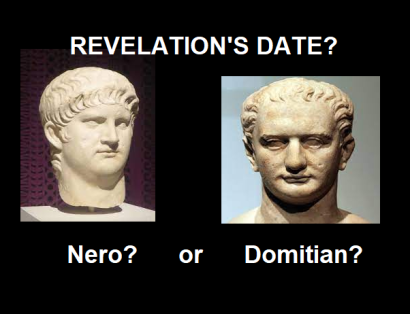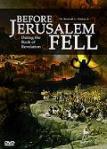TERRY ON REVELATION’S DATE (1)
PMW 2024-007 by Milton S. Terry
Two different opinions have long prevailed respecting the date of the Apocalypse. One rests mainly on a statement of Irenæus, who seems to place the composition in the latter part of the reign of Domitian (A.D. 96). The other is based upon internal evidence and maintains that the book was written before the destruction of Jerusalem. The most recent criticism, which finds documents of different authorship incorporated in the work, assigns some of the documents to an early and some to a later date. Deferring for the present the several hypotheses of the composite origin of the book, we may briefly state the arguments touching the date as follows:
Irenaeus’ statement
Irenæus, Bishop of Lyons, says that in his boyhood he had conversed with Polycarp and heard him tell of his personal fellowship with the apostle John (Eusebius, Eccl. Hist. 5:20). In speaking of the name of the Antichrist which is concealed in the mystic number given in Revelation 13:18, he says: “If it were necessary to have his name distinctly announced at the present time it would doubtless have been announced by him who saw the Apocalypse; for it was not a great while ago that [it or he] was seen (οὐδὲ γὰρ πρὸ πολλοὺ χρόνου ἑωράθη; oude gar pro pollou chronou eorathe), but almost in our own generation, toward the end of Domitian’s reign” (Irenaeus, Ag. Here. 5:30).
Here the critical reader will observe that the subject of the verb ἑωράθη (eorathe) “was seen,” is ambiguous and may be understood either of John or the Apocalypse. To assert, as some do, that the only grammatical and legitimate construction requires us to understand the Apocalypse rather than John as the subject of the verb is arbitrary and presumptuous. To say the least, in fairness, one construction is as correct and legitimate as the other.

Before Jerusalem Fell Lecture
DVD by Ken Gentry
A summary of the evidence for Revelation’s early date. Helpful, succinct introduction to Revelation’s pre-AD 70 composition.
See more study materials at: www.KennethGentry.com
But why should he say that the book was recently seen? The point he evidently aims to make is that the man who saw the visions of the Apocalypse had lived almost into the times to which Irenæus belonged. Thus, had it been needful to declare the name of the Antichrist, he would himself have done it. The time when John saw the Apocalypse was of no consequence for determining the name of Antichrist so long as the apostle himself was yet alive. There is more reason for believing that the reference is to the Apocalypse [sic: “the Apostle”] in the fact that Irenæus elsewhere says that John lived on into the times of Trajan.
Sparse evidence
But admitting that Irenæus refers to the Apocalypse as having been seen near the close of Domitian’s reign, his ambiguous statement is the only external evidence of any real value for determining the question. All other testimonies are later and, like the numerous statements of Eusebius, seem to be either repeated from Irenæus or based on mere inferences. And it is notorious that even Eusebius, after quoting Irenæus and others, leaves the question of the authorship of the Apocalypse in doubt.
Heretical sects
It has been claimed that the early date is incompatible with the existence of such heretical sects as the Nicolaitans mentioned in Revelation 2:6,15. This must have required more time for their development. But the most rational explanation of the Nicolaitans indicates the very opposite. For these libertines were the first troublers of the Church and the name itself is a symbolical designation for those destroyers of the people, who, like the Balaamites and Jezebelites of the same chapter (vv. 14, 20), taught the mischievous error of licentious freedom, even “to eat things sacrificed to idols and to commit fornication.” These evils were among the earliest with which the Church had to contend (Acts 15:20, 29; 1 Cor. 8:7–13; 6:13–20). There is no conclusive evidence that any sect of this name existed in the early Church. All that writers like Irenæus, Epiphanius, and Tertullian say about their springing from the Nicolas of Acts 6:5, is justly open to suspicion.
Seven churches
It is further argued that the churches of Asia must have existed for some time. Because some had, like Ephesus and Sardis and Laodicea, lapsed from their first love, had become lukewarm, and were ready to die. But such a plea can be allowed no weight in view of the abundant evidence of other defections in apostolic times. How long was it after Paul founded the churches of Galatia that he was compelled to write, “I marvel that ye are so quickly changing from him that called you in the grace of Christ unto a different gospel?” (Gal. 1:6). How soon after his departure did false apostles and deceitful workers and heretical teachers arise in the church of Corinth? See: 1 Corinthians 5:1, 7; 11:18 –21; 15:12; 2 Corinthians 2:17; 11:13; Philippians 3:18; Romans 16:17. There is no apostasy or defection mentioned in connection with the seven churches, which might not have arisen in any Jewish-Gentile church of apostolic times in less than two years after the date of its foundation.
The Early Date of Revelation and the End Times: An Amillennial Partial Preterist Perspective
By Robert Hillegonds
This book presents a strong, contemporary case in support of the early dating of Revelation. He builds on Before Jerusalem Fell and brings additional arguments to bear.
See more study materials at: www.KennethGentry.com
Ecclesiastical bishopric
Some believe that the phrase “angel of the church,” employed at the beginning of each of the epistles, implies an advance in ecclesiastical organization beyond the simple constitution of the first period. This is based on the assumption that angel means bishop and that the Church had no bishops before A.D. 68 who were different from presbyters. But there is no sufficient evidence that some churches were without a special bishop, or responsible pastor, even in apostolic times. And, were this not the case, the opinion that “angel of the church” in the Apocalypse means the pastor, or bishop, is without authority. Much rather is it to be regarded as a symbolical title of the whole Church in its personnel (see our interpretation in loco); for the words both of praise and of censure are obviously intended, not for one individual like the pastor, but for the good of all. They are not addressed to the Church as an organic body (the candlestick), but to its personal constituents, who should all be like so many morning stars (Rev. 2:28; cp. 1 Cor. 15:41).
Laodicean Earthquake
The overthrow of Laodicea by an earthquake (Pliny, Nat. Hist. 5.41; Tacitus, Annals 14.27) has been cited as bearing on this question of date. But, in the first place, it cannot be shown that the church there was destroyed by the earthquake. Furthermore, the statement of Tacitus is that, having been overthrown by an earthquake, the city recovered from its fall in Nero’s reign and regained its former glory by means of its own resources. This corresponds notably with what is said in Revelation 3:17 and shows that the place was in a flourishing condition in the time of Nero. Paul’s reference to this church in Colossians 4:16, abundantly refutes all arguments against the early date which are based on the destruction of Laodicea by earthquake.

Blessed Is He Who Reads: A Primer on the Book of Revelation
By Larry E. Ball
A basic survey of Revelation from an orthodox, evangelical, and Reformed preterist perspective. Ball understands John to be focusing on the destruction of Jerusalem and the temple in AD 70. Insightful. Easy to read.
For more Christian studies see: www.KennethGentry.com
Kenneth L. Gentry Jr.'s Blog
- Kenneth L. Gentry Jr.'s profile
- 85 followers



